50 years ago today, Hungarian sculptor and architecture professor Ernő Rubik applied for a patent for his “Magic Cube” in Hungary. The first Rubik’s Cubes reached Budapest toy shops two years later. READ what Rubik was up to when he invented the cube… (1975)

From 1971 to 1979, Rubik was a professor of architecture at the Budapest College of Applied Arts. Years and years later he told CNN that he was trying to find a good challenge for his students.
His original cube was made with blocks of wood and rubber bands to hold the construct together. Because of the rigidly planned economy in communist Hungary, it took him years to find a manufacturing firm that could make a prototype, but rather than debuting in Hungary, Rubik licensed the “Magic Cube” to Ideal Toys, a US company in 1979.
Ideal rebranded The Magic Cube to the Rubik’s Cube before its introduction to an international audience in 1980, and the rest, they say, is history.
MORE Good News on this Date:
- Thomas Jefferson offered to restock the shelves of the Library of Congress, which had been destroyed in the War of 1812, selling Congress more than 6,000 books from his own library–twice as many as had burned (1815)
- First airplane rescue at sea near Cuba via USS Terry (1911)
- Happy 73rd Birthday to Phil Collins, the drummer, and lead singer of Genesis (1951)
- The first successful trials to treat sickle-cell disease took place at the US National Institutes of Health (1995)
- Belgium legally recognized same-sex marriage (2003)
- Iraqis voted in their country’s first free election in a half-century (2005)
105 years ago today, Mazda was incorporated as “Toyo Cork Kogyo Co. Ltd.” a cork-making factory, by Jujiro Matsuda. 11 years later, it started producing automobiles and never looked back. The name Mazda was derived from Ahura Mazda, the god of harmony, intelligence, and wisdom in Zoroastrianism. Many carmakers capture a loyal fanbase, and Mazda is certainly one of them, and boasts not only a history of innovation and motorsport success but also some very well-received and beloved cars.
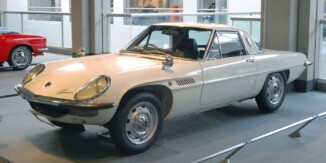
The first major breakthrough Mazda achieved was by designing a reliable and powerful Wankel rotary engine for the Mazda Cosmo. Originally developed by a German innovator and sold by the firm NSU, the Wankel engine would eventually be abandoned by Germans, the French, and the Americans, leaving Mazda as the flagship producer of this strange ICE design to this very day.
The Cosmo provided Mazda with a “halo effect” of positive, space-race-inspired innovation, but it was in 1990 that the marque found its best mark with the Miata, or MX-5—the best-selling two-seater coupe in history.
As of 8 years ago, over 1 million MX-5s/Miatas had been sold globally. The original MX-5 was launched at a time when small roadsters had almost disappeared from the market, with the Alfa Romeo Spider being one of the only comparable models still in production at the time. It was a throwback to several beloved cars like the MG B, Triumph TR7, Triumph Spitfire, and Fiat Spider.

With a front-mounted engine, rear-wheel drive, 50×50 weight distribution, and a total weight of under 2,500 kg, all its iterations have been fantastically driveable.
In 2009, English automotive critic Jeremy Clarkson wrote: “The fact is that if you want a sports car, the MX-5 is perfect. Nothing on the road will give you better value. Nothing will give you so much fun. The only reason I’m giving it five stars is because I can’t give it fourteen.” (1920)
152 years ago today, Around the World in Eighty Days was serially published. In Jules Verne’s 11th novel, Phileas Fogg of London and his newly employed French valet Passepartout attempt to circumnavigate the world in 80 days on a wager of £20,000 (equivalent to £1.9 million in 2019) set by his friends at the Reform Club. It is one of Verne’s most acclaimed works.
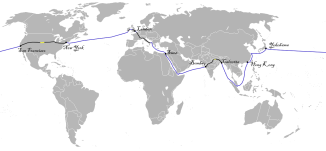
Fogg is a gentleman who is “exact”, as in, he has a perfect and routine life right down to the number of steps he walks to the temperature of his shaving water. Upon taking the wager he departs a train from London that night on a trip first to the Suez Canal via Turin and Brindisi, Italy, from which he arrives in Egypt via steamer.
From Suez another steamship takes Fogg and Passepartout to Bombay. Then the trip goes on via a train to Calcutta, steamer to Hong Kong, steamer to Yokohama, and then on to San Francisco. Taking the trans-continental railway to New York, Fogg departs for Ireland, where he realizes he won’t make his wager until Passepartout comes up with an important discovery.
Throughout the journey, a pair of subplots enrich the book with such a darling narrative that it’s no surprise it has been adapted into a film 5 times in the last 100 years, 6 if you count the short film featuring Tweetie Bird.
In 1889, journalist Nellie Bly undertook a trip around the world in 80 days for her newspaper, the New York World. She managed to do the journey within 72 days, meeting Verne in Amiens. Her book Around the World in Seventy-Two Days became a best seller. (1873)
36 years ago today, the Luxor Statue Cache was uncovered near the city of Luxor, Egypt. Containing 8 breathtaking sculptures of alabaster, grey granite, and quartzite depicting several deities and pharaohs, they exquisitely capture the skill of the New Dynasty’s artists. Originally five statues were found at a three-foot depth below a covering layer of small stones; eventually 26 statues were uncovered with some being damaged prior to burial.
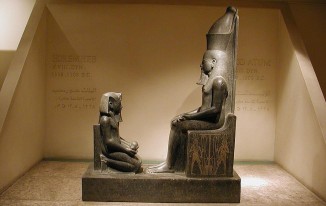
The excavation was launched in 1989 under the authority of Mahammed el-Saghir, with routine maintenance by the Luxor Antiquities Inspectorate. The Luxor cache was buried during the Roman conversion of the area into a military camp. (1989)
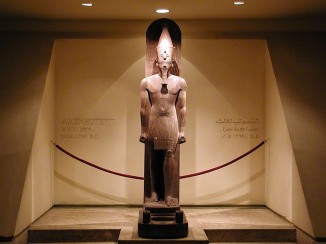
35 years ago, Ray Kurzweil published The Age of Intelligent Machines, described as a tour-de-force in its time, in which the author predicted with deeply commendable accuracy, the rise of many of our technological staples today. A transhumanist and futurist, Kurzweil doesn’t lament the rise of artificial intelligence in the book, but rather takes a neutral sort of stance on the subject, saying that AI’s clear-out of human labor in sectors like communications, innovation, teaching, and transportation, will force us all to think more deeply on what it means to be human.
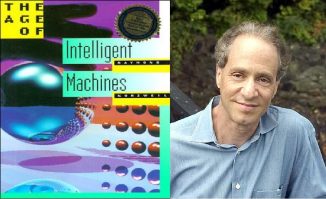
Kurzweil explains that the “functionality per unit cost” in the computer industry has been increasing exponentially for decades. He says computer memory costs one one-hundred millionth of what it did in 1950, for example. If these trends continue, Kurzweil argues, we will see a “translating telephone” by 2010, intelligent assistants by the mid-1990s, and a “completely driverless car” by “well into the first half” of the 21st century. He anticipates we will prove our identity by finger and voice prints as well.
“Facts alone do not constitute knowledge. For information to become knowledge, it must incorporate the relationships between ideas. And for the knowledge to be useful, the links describing how concepts interact must be easily accessed, updated, and manipulated,” Kurzweil writes regarding the claim that AI can’t access the level of understanding to create art or knowledge. As a high schooler, Kurzweil programmed a computer to create music on its own, getting the opportunity to show computing’s capabilities and disprove this notion in a demonstration on the CBS television show I’ve Got a Secret, in 1965. (1990)
And, 80 years ago today, 500 Allied prisoners of war from the Bataan Death March were liberated during World War II from a Japanese POW camp in the Philippines. 121 US Rangers, supported by several hundred Filipino guerrilla fighters, trekked 30 miles, then raided the Cabanatuan prison camp using intelligence gained from Alamo Scouts disguised as locals. ‘The Great Raid’ lasted thirty minutes. (1945)

Happy Birthday to the great actor Gene Hackman who turns 95 years old today. Nominated for five Academy Awards, he won the Best Actor statue at age 41—after years of personal struggle and hardship—for his role as a NYC cop in the critically acclaimed thriller The French Connection. He won a second Oscar for his role in the 1992 Clint Eastwood Western, Unforgiven.
He was nominated again for his gripping portrayal of an FBI agent in Mississippi Burning (1988), and is also saluted for major contributions to hit movies such as The Firm, Get Shorty, Enemy of the State (a GNN favorite co-starring Will Smith), The Royal Tenenbaums, and The Conversation.
He retired in 2004, but he went on to write 6 novels as an author—three historical fiction novels, a Depression-era tale of murder, and a tale of love and revenge set in the Old West entitled Payback at Morning Peak. His most recently published, in 2013, was a police thriller called Pursuit. (1930) WATCH the surprisingly exciting trailer for The French Connection…
And, on this day in 1969, The Beatles played their last public concert, performing on the rooftop of Apple Records, surprising lunchtime pedestrians on a blustery cold day. The group, which invited Billy Preston to sit in on keyboards, hadn’t played in public for three years. The unannounced London appearance was eventually broken up by the police, but all the memorable scenes (including people gazing up in the streets) were filmed for a documentary—a total of nine takes of five songs: Get Back, Don’t Let Me Down, I’ve Got a Feeling, One After 909, and Dig a Pony.
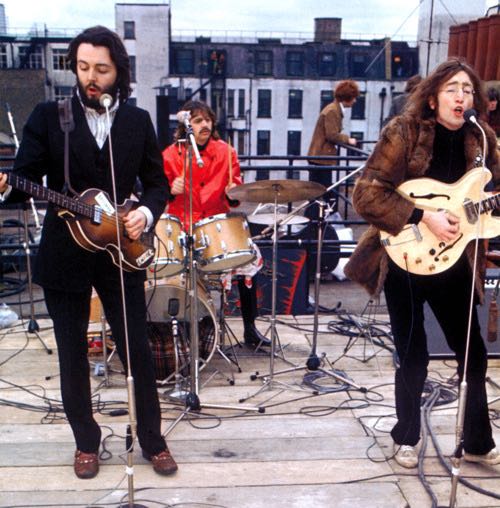
The Beatles realized that the concert would be shut down, as police ascended to the roof, but continued to play for several more minutes. Paul McCartney improvised the lyrics of his song “Get Back” to reflect the situation, “You’ve been playing on the roofs again, and you know your Momma doesn’t like it, she’s gonna have you arrested!” The concert came to an end with the conclusion of Get Back, with John Lennon saying, “I’d like to say thank you on behalf of the group and ourselves, and I hope we’ve passed the audition.”
And, 199 years ago today, a groundbreaking piece of civil engineering debuted– the massive Menai Bridge opened, cutting nine hours from the journey between Wales and London.

A triumph for its designer and engineer Thomas Telford, it was the biggest suspension bridge in the world at the time. Sixteen huge chains held up 579 feet of deck, allowing 100 feet of clear space beneath for tall ships navigating the seaway underneath.
 With a length of almost 6 football fields (520 meters), it spans the dangerous waters of the Menai Strait, connecting the island of Anglesey to the Wales mainland. (1826)
With a length of almost 6 football fields (520 meters), it spans the dangerous waters of the Menai Strait, connecting the island of Anglesey to the Wales mainland. (1826)
SHARE the Memories, Milestones, and Music…




















